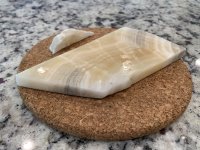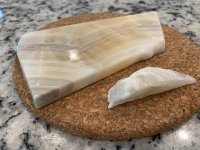So in my continuing attempt to explore odd stones for honing I picked up a nice piece of striped Onyx to play with. I had to cut a piece off one end where the saw work was incomplete. I wound up with a nice overall shape to try out. This specimen is very translucent across most of the stone and also had areas of opacity.
Now I’m in the flattening process. I’ll probably work one side up to 600# & the other to maybe 1200# or so just to establish a point of reference. Has anyone else dabbled with these stones here? Thanks
Now I’m in the flattening process. I’ll probably work one side up to 600# & the other to maybe 1200# or so just to establish a point of reference. Has anyone else dabbled with these stones here? Thanks
Attachments
Last edited:


